‘Just when the caterpillar thought the world was over, she became a butterfly.’ –Ladies of the Borobudur
After attending HE 12th Gyaltsab Rinpoche’s empowerment and activities in Batam Island and visiting some other Buddhist temples there, I traveled to the sacred land of Java, Indonesia, first to the city of Yogyakarta. This whole region is significant in Buddhist history and legacy and is dotted with ancient Buddhist temples everywhere. In particular, it has a strong connection to Guru Padmasambhava, more on that soon! I stayed a couple of nights in Yogyakarta, which seemed like a lovely, mellow and vibrant city. The people I met were very open, friendly and spoke good English. There was no street harassment, other than from taxi drivers asking if I needed a taxi. Again, the daytime heat was intensely hot though. Drenched in sweat after only half an hour walking outside. The words ‘uncomfortable’ and sticky springs to mind!
Music? Borobudur Jaya and for one of the wonders of the world, Wonderful World by Louis Armstrong.
Getting to Borobudur and Day One of the Monlam

Getting to Borobudur from Yogyakarta is easy by car. I booked a Grab taxi (which costs around 10GBP) , and took about one hour to arrive. The first day of the Kagyu Monlam started at 4am, and I was not feeling sick at the time, so woke up early for it.
The location of the Monlam tent was right next to the Borobodur stupa and so could see its outline in the dark. It has a square-shaped base, and is a mandala, so I did some circumabulation and chants around the base and gazed at the view from the hill it is located on.
Scholars concluded that in the eighth century the Shailendra dynasty of Sumatra conquered Java, established Buddhism as the official religion, and financed the building of the massive fane of Borobudur (i.e., “Many Buddhas”). Sanjaya and Sailendra shared power in central Java for a century and a half, with alternating succession from 732 until 882. During this time many Hindu and Buddhist monuments were built on the plains and mountains around the Kedu Plain. Buddhist monuments, including Borobudur, were erected around the same period as the Hindu Prambanan temple compound. Construction of Buddhist temples, including Borobudur, at that time was possible because Sanjaya’s immediate successor, Rakai Panangkaran, granted his permission to the Buddhist followers to build such temples. In fact, to show his respect, Panangkaran gave the village of Kalasan to the Buddhist community, as is written in the Kalasan Charter dated 779 AD.
Borobudur lay hidden for centuries under layers of volcanic ash and jungle growth. The facts behind its abandonment remain a mystery. It is not known when active use of the monument and Buddhist pilgrimage to it ceased. From 1907, it was gradually restored, led by Theodoor van Erp, a Dutch army engineer and renovated as a UNESCO world heritage site in 1973. The monument is said to be the single most visited tourist attraction in Indonesia.
On 21 January 1985, nine stupas were badly damaged by nine bombs. In 1991, a blind Muslim preacher, Husein Ali Al Habsyie, was sentenced to life imprisonment for masterminding a series of bombings in the mid-1980s, including the temple attack. In June 2012, Borobudur was recorded in the Guinness Book of World Records as the world’s largest Buddhist temple.
Later that night, I started to cough a lot and felt my throat getting more sore and a fever, so went to sleep early.






16 Arhat empowerment and cancellation of other activities due to sickness

On the second day of the Monlam, the sickness/cough had become much worse, but I was intent on going to the 16 Arhat empowerment being given in the second session of the day. At that time, we did not know Rinpoche was also very sick with flu too. However, before he gave the empowerment, Rinpoche explained that he had become sick with flu since Batam Island and had been advised to rest by doctors due to potential issues with his liver, and to cancel the rest of his activities in Indonesia. Although it was sad he had to cancel, he explained that he had seen the image of Borobudur as a teenager and had always wanted to visit, so in that respect the visit to Indonesia had been a personal wish fulfilled and also a new Dharma centre had been opened.

Then Gyaltsab Rinpoche started to explain the background of the 16 Arhats and the Shakyamuni Buddha. The Sixteen Arhats (གནས་བརྟན་བཅུ་དྲུག, “Neten Chudrug”) are a group of legendary Arhats in Buddhism. The grouping of sixteen Arhats was brought to China, and later to Tibet, from India. In China, an expanded group of Eighteen Arhats later became much more popular, but worship of the sixteen Arhats still continues to the present day in China, Japan and Tibet.
In Japan, sixteen Arhats are particularly popular in Zen Buddhism, where they are treated as examples of behaviour. In Tibet, the sixteen Arhats, also known as sixteen sthaviras (‘elders’) are the subject of a liturgical practice associated with the festival of the Buddha’s birth, composed by the Kashmiri teacher Shakyahribhadra (1127-1225). Rāhula (Pāli and Sanskrit) was the only son of Siddhārtha Gautama (commonly known as the Buddha) and his wife, princess Yaśodharā.
Rinpoche explained that the Arhats often had 500-1000 attendant followers and that wherever they went the attendants would follow. I cannot find a recording of the teachings, otherwise I would have transcribed it. He ended by explaining that the sixth Buddha is predicted to be an incarnation of the Karmapa.

As Rinpoche bestowed the empowerment, which involved visualisations of the Buddha surrounded by the 16 Arhats at various points in the body,the whole body became filled with these ‘chakras’ at the joints and so on, a beautiful and blissful experience indeed.
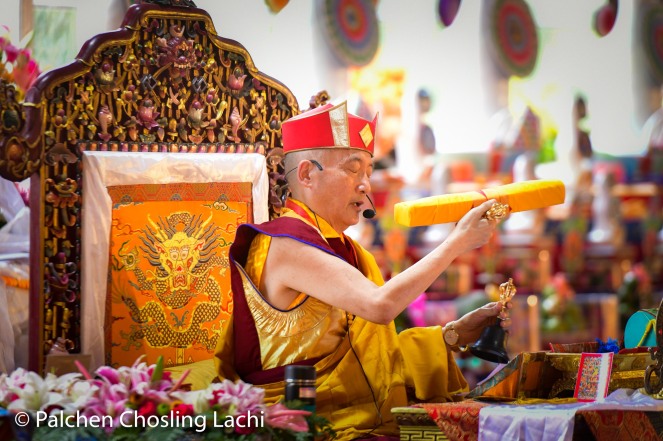

Third Day of the Monlam and entering the Borobudur temple
On the third day of the Monlam, despite also being very sick with flu, I refused to be deterred and bought the ticket to enter the Borobudur temple complex itself (455K IDR, about 25 GBP), there were set times and set amounts of people who could enter the temple every day, and I was only able to book one that went up around 11- 12pm, in the midday heat! So it was a ‘hot’ and ‘wet’ experience to say the least! The Monlam Procession of the Kangyur around the base of Borobodur happened just before the visit, so I was able to attend both.


The tickets to enter the temple itself are booked online in advance, and once purchased, one gets a wristband that is scanned by a security guard to enter. Despite the sweltering midday heat (even sheltering under an umbrella) it was wonderful to see the stone art murals of Buddha’s life and the famous perforated stupas that contain Buddha statues inside them. There were some headless Buddhas too.
The sacred mandala geometry of the temple
The temple consists of nine stacked platforms, six square and three circular, topped by a central dome. It is decorated with 2,672 relief panels and 504 Buddha statues. The central, uppermost dome is surrounded by 72 Buddha statues, each seated inside a perforated stupa.
Built in the 9th century during the reign of the Sailendra Dynasty, the temple design follows Javanese Buddhist architecture, which blends the Indonesian indigenous tradition of ancestor worship and the Buddhist concept of attaining Nirvana. The temple demonstrates the influences of Gupta art that reflects India’s influence on the region, yet there are enough indigenous scenes and elements incorporated to make Borobudur uniquely Indonesian.

The temple is constructed in the shape of a mandala, with three main levels and a top stupa. The three levels, as can be seen in this image represent the three dhatus/expanses, and they depict the three phases in the attainment of Nirvana. A pyramidal base with five square terraces that represent Kamadhatu, the world of desires, where we are bound to our desires. The trunk of a cone with three circular platforms represent Rupadhatu, the world of forms, where one abandons their desires but are still bound to name and form. A monumental stupa located at the top represents Arupadhatu the formless world, where there is no longer either name or form.
The base and the balustrades that enclose the square terraces are decorated in reliefs, that have been sculpted in the stone, thus illustrating the different phases of a being’s progression towards awakening, and episodes from the life of Buddha. It is also said that the Jonangpas consider the Borobudur temple to be a Kālacakra mandala. I went up to each level and circumambulated each level chanting mantras.

Even at the top of the hill on which the temple is located, one could hear the loud chants of the many mosques in the town, a reminder of how Islamism had violently taken over this previously predominantly Buddhist and Hindu area of Java, and the bombing of the temple in the 1990s by radical Muslims. The different religions seem to live peacefully with each other though (for now at least).
Here are some photos I took of the murals and perforated stupas and view from the top of the hill:


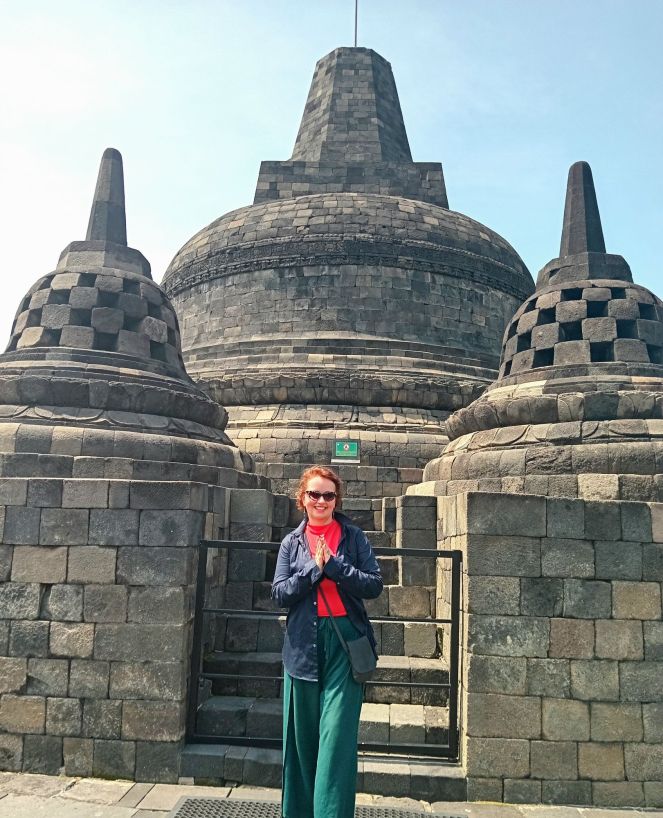




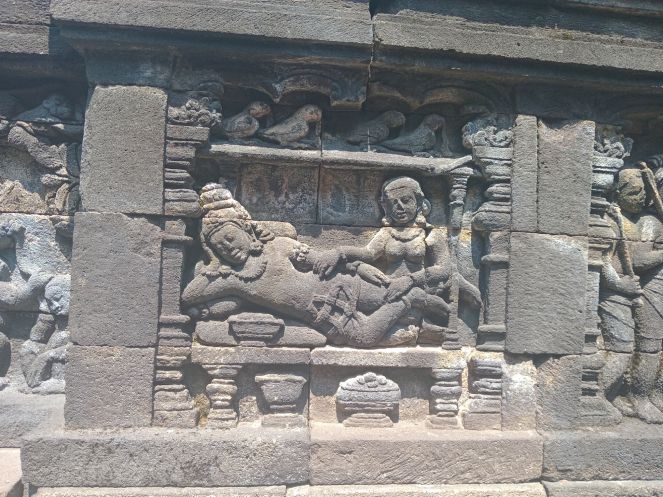

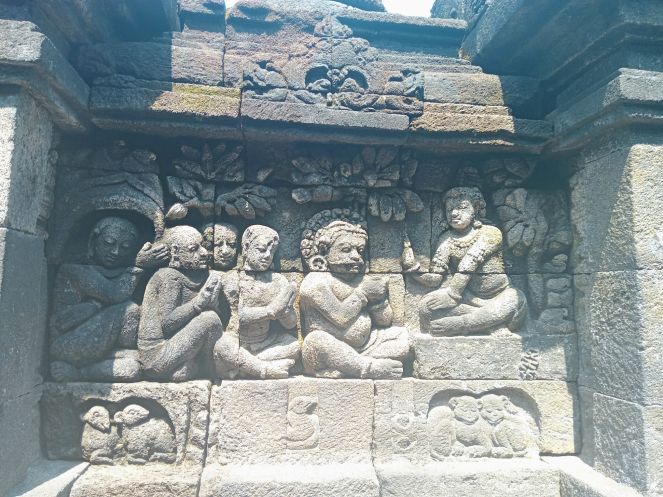





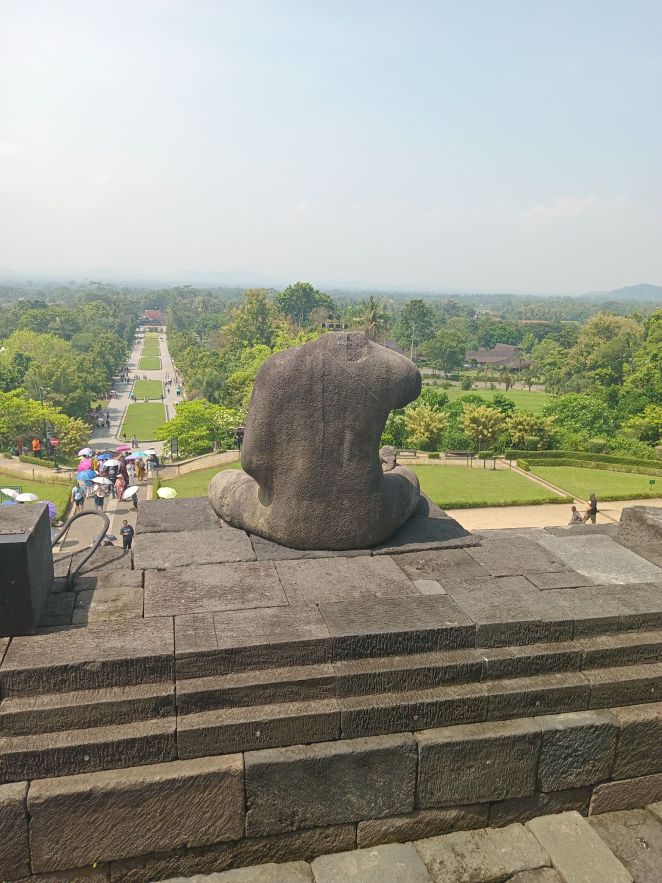

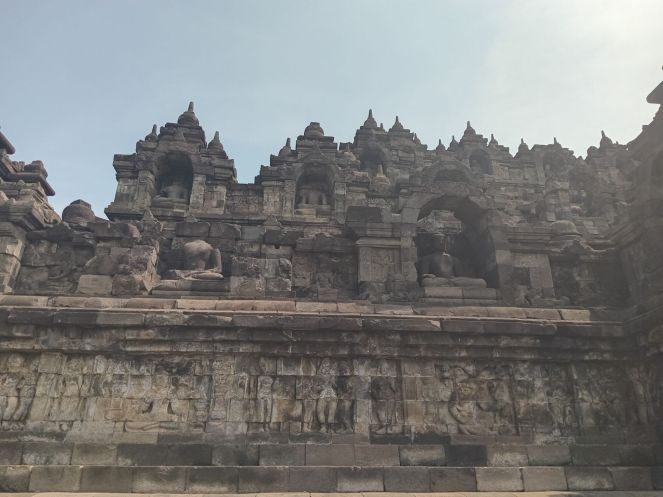


The Marme Monlam and a ‘brilliant white’ Borobudur
During the afternoon, I went to visit another sacred place near Borobudur, which I will write about in the next article. I got back just in time and was overjoyed to see 12th Gyaltsab Rinpoche arriving for the final session of the light offering Marme Monlam.
In the final session of the light offering, Marme Monlam, the recorded chants of the 17th Gyalwang Karmapa brought tears to my (and others’) eyes as a reminder of his wonderful voice and how he should have been able to attend these events and teach in SE Asia.


Everyone then went outside to circumambulate and see a brilliant white lit-up temple (a lovely surprise that I had not been expecting), and the monastic group stood outside for photos.


Here are some photos I took on my mobile phone camera below:


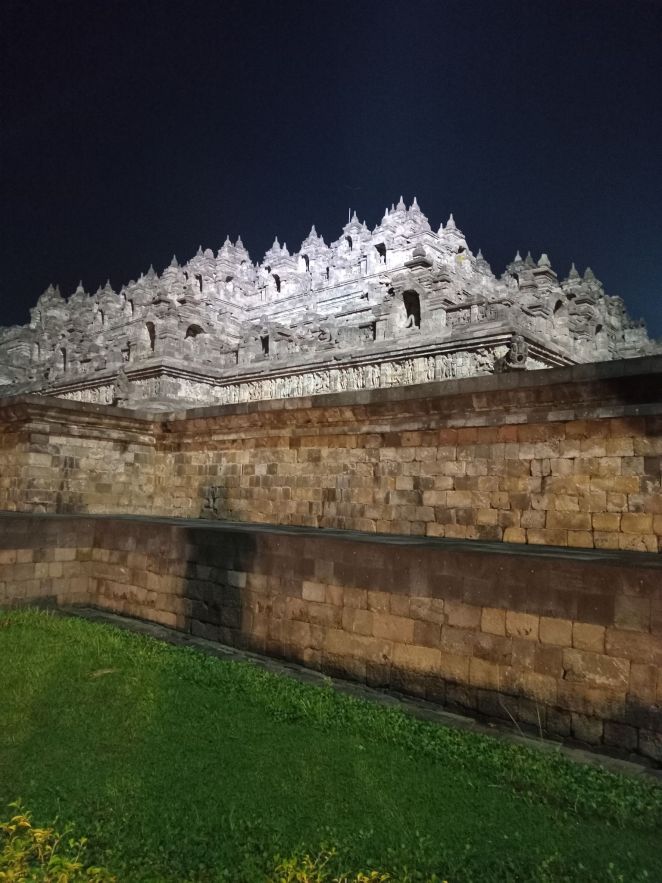






Great work Adellee,
nice shots of the headless Buddhas. Tai Situpa also recently visited. I was there at one of the earliest monlams, truly magnificent. Your good fortune is a Blessing for all Sentient surfers.
Thank you!